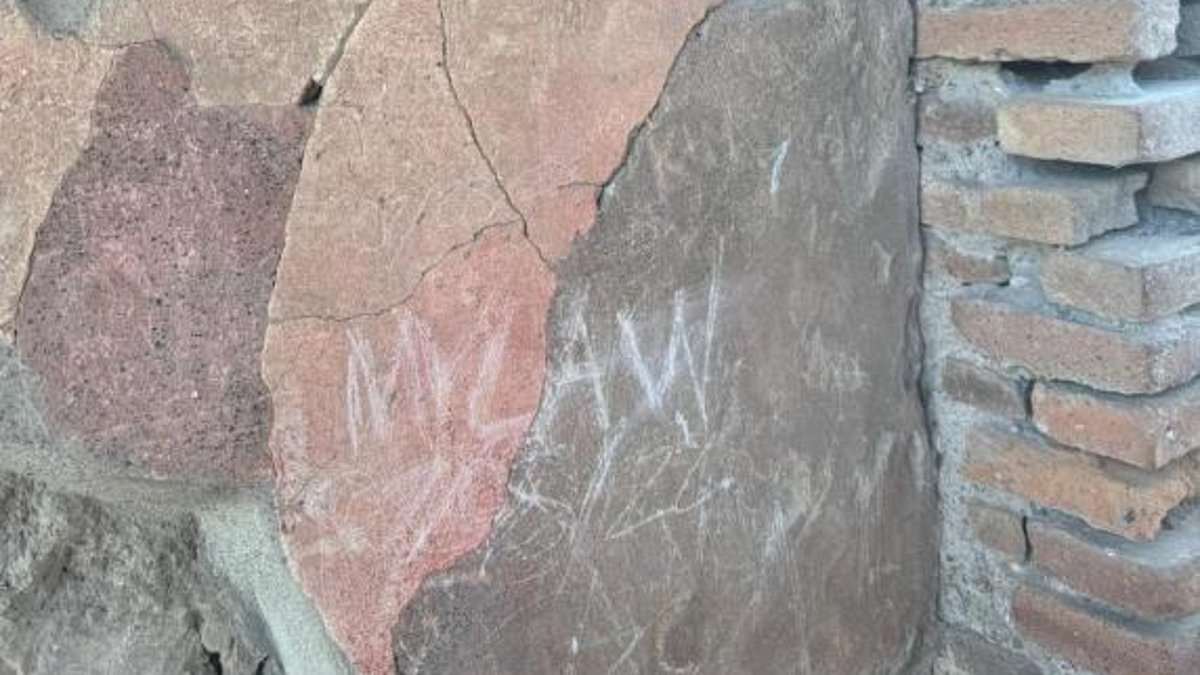A British tourist has received a huge rap on the knuckles by Italian authorities after he carved his and his two daughters’ initials onto the wall of one of the most famous and protected ancient sites in Pompeii.
The 37-year-old made five engravings in total – comprising their initials and the date – with a blunt object onto the wall of the House of the Vestal Virgins, which is a recognised UNESCO World Heritage Site.
Pompeii sits beneath Mt Vesuvius and was famously buried and preserved for posterity by a massive eruption in 79AD.
The House of the Vestal Virgins at one time housed the virgin priestesses of the Roman goddess Vesta, who ruled over the hearth, home and family.
It suffered some damage during the Second World War, but much of the site’s deterioration has been caused by weathering over the centuries.
Nevertheless, tourists marvel at the mosaics and frescoes that adorned the house built nearly 2,000 years ago.
The new graffiti comprises the letters JW, LMW and MW, alongside MLAW and the date 07/08/24, images from the site show.
According to Italian news outlet Secolo d’Italia, staff had noticed the man standing close to the frescoed section at the entrance to the House of the Vestrals and discovered the engravings after he left.
Outraged by the graffiti, they identified the man and reported him to the Public Prosecutor’s Office at the Court of Torre Annunziata, Corriere Della Sera reports.
When asked to explain himself, the man is said to have apologised and that he had wanted to leave a record of the family having visited the historic site.
The man has now been cited for damaging cultural heritage, according to Italian news outlet ANSA and it is likely he will have to pay for any restoration.
This is not the first time British tourists have run into trouble at the beloved site, which is one of Italy’s most popular historic attractions.
In June, a tourist was caught carving his name on an ancient wall at Pompeii.
The man, who is from Kazakhstan, was reportedly caught red-handed damaging one of the walls in the town, which sits beneath Mt Vesuvius and was buried by the volcano’s 79AD eruption.
The unnamed vandal was stopped while he was engraving ‘Ali’ on light plaster in the House of the Ceii, an ancient villa that probably belonged to the magistrate Lucius Ceius Secundus.
The Italian authorities have said that the man will be made to pay for restoration work to be carried out on the wall to remove the graffiti after he was reported to the police.
It comes a year after a tourist from Bristol was caught etching his and his girlfriend’s names into the 2,000-year-old Colosseum in Rome.
The park director, Gabriel Zuchtriegel, said at the time: ‘An uncivilised act. Thanks to the new law supported by Minister Gennaro Sangiuliano, the perpetrator of the crime will have to pay for the restoration of the wall.
‘Well done to the ministry collaborators and the Ales company who promptly intervened. Excellent collaboration with the police, who we thank for their promptness.’
The Pompeii Archaeological Park says on its website that the House of the Ceii is ‘one of the rare examples of ancient dwellings in the late-Samnite period (2nd century BC).’
They also say: ‘Upon entering the house one notices the impluvium bath which is made of fragments of amphorae set on edge, a common technique used in Greece and attested in Pompeii also in the House of the Ancient Hunt.
‘The back wall in the small garden is decorated with wild animals, a highly successful theme in the decoration of open areas.
‘The side walls depict Egyptian-style landscapes with animals of the Nile Delta, which probably indicated a link between the owner of the house and the cult of Isis, widespread in Pompeii in the last years of the life of the city.’
As high season approaches, Italian authorities will be policing the country’s landmarks after last summer saw a series of senseless attacks on Italy’s beloved historical sites.
In the town of Herculaneum, which was also covered in volcanic ash when Vesuvius erupted in 79AD, a tourist from the Netherlands was reprimanded for ‘signing’ an ancient wall.
Then in August, two tourists from Germany were detained for covering a historical landmark in Florence with football graffiti.
The men are reported to have used black spray paint to write ‘DKS 1860’ on the 460-year-old columns of Florence’s iconic Vasari Corridor.
The corridor connects the city’s treasured Uffizi Gallery and the Pitti Palace and was originally built for the powerful Medici family.
And in a now-famous shocking incident, a Bulgarian-born Bristol-based fitness instructor was filmed smiling as he vandalised the wall of the Colosseum.
Ivan Dimitrov, 27, was on holiday in Rome with girlfriend Hayley Bracey, 33, when he was caught carving the words ‘Ivan and Hayley 23’ into the brickwork with a set of keys.
